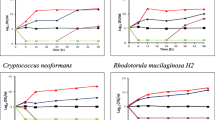Abstract
Talaromyces (Penicillium) marneffei can cause fatal disseminated infection in immunocompromised hosts. However, therapeutic strategies for the mycosis are limited. Reports of the other fungi suggest that berberine, a component of traditional herb, inhibitors interact with antifungal agents to improve the treatment outcomes. In the study, we evaluated the in vitro efficacy of berberine in combination with conventional antifungal agents against the pathogenic yeast form of T. marneffei. We demonstrate the synergistic effect of combination of berberine with fluconazole (52.38%), itraconazole (66.67%), voriconazole (71.43%), amphotericin B (71.43%) or caspofungin (52.38%) of T. marneffei strains, respectively. Time–kill curves confirmed the synergistic interaction, and no antagonistic was observed in all of the combinations. In conclusion, berberine could enhance the efficacy of conventional antifungal agents against the yeast form of T. marneffei in vitro. The results indicated berberine might have a potential role in combination therapy for talaromycosis.

Similar content being viewed by others
References
Supparatpinyo K, Khamwan C, Baosoung V, Nelson KE, Sirisanthana T. Disseminated Penicillium marneffei infection in southeast Asia. Lancet. 1994;344(8915):110–3.
Hu Y, Zhang J, Li X, Yang Y, Zhang Y, Ma J, et al. Penicillium marneffei infection: an emerging disease in mainland China. Mycopathologia. 2013;175(1–2):57–67. https://doi.org/10.1007/s11046-012-9577-0.
Mo D, Li X, Wei L, Sun C, Liang H, Cao C. In vitro interactions of calcineurin inhibitors with conventional antifungal agents against the yeast form of Penicillium marneffei. Mycopathologia. 2014;178(3–4):217–20. https://doi.org/10.1007/s11046-014-9787-8.
Cao C, Liu W, Li R, Wan Z, Qiao J. In vitro interactions of micafungin with amphotericin B, itraconazole or fluconazole against the pathogenic phase of Penicillium marneffei. J Antimicrob Chemother. 2009;63(2):340–2. https://doi.org/10.1093/jac/dkn494.
Chang Y. Effectiveness of berberine in bacillary dysentery. Zhonghua nei ke za zhi. 1959;7:741–3.
Chen C, Yu Z, Li Y, Fichna J, Storr M. Effects of berberine in the gastrointestinal tract a review of actions and therapeutic implications. Am J Chin Med. 2014;42(5):1053–70. https://doi.org/10.1142/S0192415X14500669.
Bang S, Kwon H, Hwang HS, Park KD, Kim SU, Bahn YS. 9-O-butyl-13-(4-isopropylbenzyl)berberine, KR-72, is a potent antifungal agent that inhibits the growth of Cryptococcus neoformans by regulating gene expression. PLoS ONE. 2014;9(10):e109863. https://doi.org/10.1371/journal.pone.0109863.
Quan H, Cao YY, Xu Z, Zhao JX, Gao PH, Qin XF, et al. Potent in vitro synergism of fluconazole and berberine chloride against clinical isolates of Candida albicans resistant to fluconazole. Antimicrob Agents Chemother. 2006;50(3):1096–9. https://doi.org/10.1128/AAC.50.3.1096-1099.2006.
Wayne (2008) Clinical and Laboratory Standards Institute (CLSI). Reference method for broth dilution antifungal susceptibility testing of yeasts. Approved standard, 3rd edn
Klepser ME, Wolfe EJ, Jones RN, Nightingale CH, Pfaller MA. Antifungal pharmacodynamic characteristics of fluconazole and amphotericin B tested against Candida albicans. Antimicrob Agents Chemother. 1997;41(6):1392–5.
Ning Xin-qiang CC-w. Effects of SakA on the drug stress and virulence in Talaromyces marneffei. Chin J Mycol. 2018;13(2):65–70.
Nakamoto K, Sadamori S, Hamada T. Effects of crude drugs and berberine hydrochloride on the activities of fungi. J Prosthet Dent. 1990;64(6):691–4.
Liu X, Han Y, Peng K, Liu Y, Li J, Liu H. Effect of traditional Chinese medicinal herbs on Candida spp. from patients with HIV/AIDS. Adv Dent Res. 2011;23(1):56–60. https://doi.org/10.1177/0022034511399286.
Yhj-H LEE. Berberine synergy with amphotericin B against disseminated candidiasis in mice. Biol Pharm Bull. 2005;28(3):541–4.
Shi G, Shao J, Wang T, Wu D, Wang C. Mechanism of berberine-mediated fluconazole-susceptibility enhancement in clinical fluconazole-resistant Candida tropicalis isolates. Biomed Pharmacother. 2017;93:709–12. https://doi.org/10.1016/j.biopha.2017.06.106.
Sun J, Bao H, Peng Y, Zhang H, Sun Y, Qi J, et al. Improvement of intestinal transport, absorption and anti-diabetic efficacy of berberine by using Gelucire44/14: in vitro, in situ and in vivo studies. Int J Pharm. 2018;544(1):46–54. https://doi.org/10.1016/j.ijpharm.2018.04.014.
Kawila R, Chaiwarith R, Supparatpinyo K. Clinical and laboratory characteristics of penicilliosis marneffei among patients with and without HIV infection in Northern Thailand: a retrospective study. BMC Infect Dis. 2013;13:464. https://doi.org/10.1186/1471-2334-13-464.
Wong SS, Wong KH, Hui WT, Lee SS, Lo JY, Cao L, et al. Differences in clinical and laboratory diagnostic characteristics of penicilliosis marneffei in human immunodeficiency virus (HIV)- and non-HIV-infected patients. J Clin Microbiol. 2001;39(12):4535–40. https://doi.org/10.1128/JCM.39.12.4535-4540.2001.
Acknowledgements
This study was supported by grants from the National Natural Science Foundation of China (Nos. 81571971 and 81271804) and Natural Science Foundation of Guangxi Province of China (2017GXNSFAA198004 and 20150825). The funders have no role in this study design, data collection and analysis, decision to publish or preparation of the manuscript.
Author information
Authors and Affiliations
Contributions
Gang Liang and Cun-wei Cao designed this study and drafted the article. Hong Luo and Kai-su Pan performed the antifungal susceptibility assays and time–kill curves and data collection and edited the article. Dong-yan Zheng, Yan-qing Zheng and Xiu-ying Li isolate and identify strains. Xiao-lu Luo Alex Andrianopoulos and Le-min Wen performed the data analysis and calculated the statistics. Jing Guo, Chun-yang Huang and Justin Joseph critically revised the article. Rong Hu, Yu-jiao Li and Tian-min Li provided valuable advice and supported the clinical protocol. Study funding was secured by Cunwei Cao and Gang Liang. All of the authors have read and approved the final manuscript.
Corresponding authors
Additional information
Publisher's Note
Springer Nature remains neutral with regard to jurisdictional claims in published maps and institutional affiliations.
Handling Editor: Yuping Ran.
Rights and permissions
About this article
Cite this article
Luo, H., Pan, Ks., Luo, Xl. et al. In Vitro Susceptibility of Berberine Combined with Antifungal Agents Against the Yeast Form of Talaromyces marneffei. Mycopathologia 184, 295–301 (2019). https://doi.org/10.1007/s11046-019-00325-y
Received:
Accepted:
Published:
Issue Date:
DOI: https://doi.org/10.1007/s11046-019-00325-y




